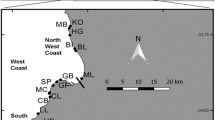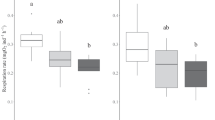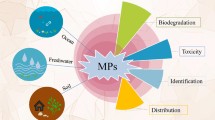Abstract
Microplastics (MPs) constitute a main environmental issue due to their threat to marine organisms and so far to humans. The lack of a fast standard protocol in MP isolation and identification from living organisms bring to challenge for the science. In this paper, an optimized protocol using potassium hydroxide 10% (KOH 10%; m/v) for digestion of mussel soft tissues (Mytilus edulis) and multi-steps of sedimentation has been developed. Efficiency higher than 99.9% of organic and mineral matter elimination was shown by application on mussels sampled on the French Atlantic coast. The identification of MPs was performed by FTIR microscopy straight on the filter and the whole analysis can be compatible with a routine goal. Fourteen MPs of four different chemical natures were found and identified in 5 pools of 3 sampled mussels. Their size ranged from 30 to 200 μm. Further investigations are now needed to evaluate the potential risk of such particles within this marine bivalve species and other filter feeders.




Similar content being viewed by others
Explore related subjects
Discover the latest articles and news from researchers in related subjects, suggested using machine learning.References
Arthur, C., Baker, J., Bamford, H., 2009. In Proceedings of the International Research Workshop on the Occurrence, Effects and Fate of Microplastic Marine Debris, NOAA Technical Memorandum NOS-OR & R-30.NOAA (p. 530). Silver Spring, September 9–11, 2008.
Boerger CM, Lattin GL, Moore SL, Moore CJ (2010) Plastic ingestion by planktivorous fishes in the North Pacific Central Gyre. Mar Pollut Bull 60:2275–2278
Bond AL, Provencher JF, Daoust PY, Lucas ZN (2014) Plastic ingestion by fulmars and shearwaters at Sable Island, Nova Scotia. Canada Mar Pollut Bull 87:68–75
Browne MA, Dissanayake A, Galloway TS, Lowe DM, Thompson RC (2008) Ingested microscopic plastic translocates to the circulatory system of the mussel, Mytilus edulis (L.) Environ Sci Technol 42:5026–5031
Carson HS, Colbert SL, Kaylor MJ, McDermid KJ (2011) Small plastic debris changes water movement and heat transfer through beach sediments. Mar Pollut Bull 62:1708–1713
Claessens M, van Cauwenberghe L, Vandegehuchte MB, Janssen CR (2013) New techniques for the detection of microplastics in sediments and field collected organisms. Mar Pollut Bull 70:227–233
Cole M, Lindeque P, Halsband C, Galloway SC (2011) Microplastics as contaminants in the marine environment: a review. Mar Pollut Bull 62:2588–2597
Cole M, Webb H, Lindeque PK, Fileman ES, Halsband C, Galloway TS (2014) Isolation of microplastics in biota-rich seawater samples and marine organisms. Sci Rep 4:4528
De Witte B, Devriese L, Bekaert K, Hoffman S, Vandermeersch G, Cooreman K, Robbens J (2014) Quality assessment of the blue mussel (Mytilus edulis): comparison between commercial and wild types. Mar Pollut Bull 85:146–155
Dehaut A, Cassone AL, Frère L, Hermabessiere L, Himber C, Rinnert E, Rivière G, Lambert C, Soudant P, Huvet A, Duflos G, Paul-Pont I (2016) Microplastics in seafood: benchmark protocol for their extraction and characterization. Environ Pollut 215:223–233
Desforges JPW, Galbraith M, Ross PS (2015) Ingestion of microplastics by zooplankton in the Northeast Pacific Ocean. Arch Environ Contam Toxicol 69:320–330
Devriese LI, Van de Meulen MD, Maes T (2015) Microplastic contamination in brown shrimp (Crangon crangon, Linnaeus 1758) from coastal waters of the Southern North Sea and Channel area. Mar Pollut Bull 98:179–187
Eriksen M, Maximenko N, Thiel M (2013) Plastic pollution in the South Pacific subtropical gyre. Mar Pollut Bull 68:71–76
Foekema EM, De Gruijter C, Mergia MT, van Franeker JA, Murk AJ, Koelmans AA (2013) Plastics in North Sea fish. Env Sci Technol 47:8818–8824
Gall SC, Thompson RC (2015) The impact of debris on marine life. Mar Pollut Bull 92:170–179
Harrison JP, Ojeda JJ, Romero-Gonzalez ME (2012) 2012. The applicability of reflectance micro-Fourier-transform infrared spectroscopy for the detection of synthetic microplastics in marine sediments. Sci Total Environ 416:455–463
Hopewell J, Dvorak R, Kosior E (2009) Plastics recycling: challenges and opportunities. Phi Trans R Soc B 364:2115–2126
Kappler A, Fisher D, Oberbeckmann S, Schernewski G, Labrenz M, Eichhorn KJ, Voit B (2016) Analysis of environmental microplastics by vibrational microspectroscopy: FTIR, Raman or both? Ana Bioanal Chem 408(29):8377–8391
Laist DW (1987) Overview of the biological effects of lost and discarded plastic debris in the marine environment. Mar Pollut Bull 18:319–326
Lee J, Hong S, Song YK, Hong SH, Jang YC, Jang M, Heo NW, Han GM, Lee MJ, Kang D, Shim WJ (2013) Relationships among the abundances of plastic debris in different size classes on beaches in South Korea. Mar Pollut Bull 77:349–354
Li J, Yang D, Li L, Shi H (2015) Microplastics in commercial bivalves from China. Environ Pollut 207:190–195
Li J, Qu X, Su L, Zhang W, Yang D, Kolandhasamy P, Li D, Shi H (2016) Microplastics in mussels along the coastal waters of China. Environ Pollut 214:177–184
Loder MGJ, Kuczera M, Mintenig S, Lorenz C, Gerdts G (2015) Focal plane array detector-based micro-fourier-transform infrared imaging for the analysis of microplastics in environmental samples. Environ Chem 12:563–581
Lucia GA, Caliani I, Marra S, Camedda A, Coppa S, Alcaro L, Campani T, Giannetti M, Coppola D, Cicero AM, Panti C, Baini M, Guerranti C, Marsili L, Massero G, Fossi MC, Matiddi M (2014) Amount and distribution of neustonic micro-plastic off the western Sardinian coast (Central-Western Mediterranean Sea). Mar Environ Res 100:10–16
Lusher AL, McHugh M, Thompson RC (2013) Occurrence of microplastics in the gastrointestinal tract of pelagic and demersal fish from the English Channel. Mar Pollut Bull 67:94–99
Mathalon A, Hill P (2014) Microplastic fibers in the intertidal ecosystem surrounding Halifax Harbor, Nova Scotia. Mar Pollut Bull 81:69–79
Michele T, Digka N, Anastasopoulou A, Tsangaris C, Mytilineou C (2016) Anthropogenic microfibres pollution in marine biota. A new and simple methodology to minimize airborne contamination Mar Pollut Bull. doi:10.1016/j.marpolbul.2016.07.050
Moore CJ (2008) Synthetic polymers in the marine environment: a rapidly increasing, long-term threat. Env Res 108:131–139
PlasticsEurope, 2015. Plastics—the facts 2015: an analysis of European plastics production, demand and waste data.
Phuong NN, Zalouk-Vergnoux A, Poirier L, Kamari A, Châtel A, Mouneyrac C, Lagarde F (2016) Is there any consistency between the microplastics found in the field and those used in laboratory experiments? Environ Pollut 211:111–123
Rocha-Santos T, Duarte AC (2015) A critical overview of the analytical approaches to the occurrence, the fate and the behavior of microplastics in the environment. Trends Anal Chem 65:47–53
Song YK, Hong SH, Jang M, Han GM, Rani M, Lee J, Shim WJ (2015) A comparison of microplastic and spectroscopic identification methods for analysis of microplastics in environmental samples. Mar Pollut Bull 93:202–209
Tanaka K, Takada H, Yamashita R, Mizukawa K, Fukuwaka MA, Watanuki Y (2013) Accumulation of plastic-derived chemicals in tissues of seabirds ingesting marine plastics. Mar Pollut Bull 69:219–222
Thompson RC, Olsen Y, Mitchell RP, Davis A, Rowland SJ, John AWG, McGonigle D, Russell AE (2004) Lost at sea: where is all the plastic? Science 304:838
Thompson, R.C., Swan, S.H., Moore, C.J., vom Saal, F.S., 2009. Our plastic age. Phil Trans R Soc B 364, 1973–1976.
Van Cauwenberghe L, Janssen CR (2014) Microplastics in bivalves cultured for human consumption. Environ Pollut 193:65–70
Van Cauwenberghe L, Claessens M, Vandegehuchte MB, Janssen CR (2015) Microplastics are taken up by mussels (Mytilus edulis) and lugworms (Arenicola marina) living in natural habitats. Environ Pollut 199:10–17
Vianello A, Boldrin A, Guerriero P, Moschino V, Rella R, Sturaro A, Da Ros L (2013) Microplastic particles in sediments of lagoon of Venice, Italy: first observations on occurrence, spatial patterns and identification. Estu Coast Shelf Sci 130:54–61
Woodall LC, Sanchez-Vidal A, Canals M, Paterson GLJ, Coppock R, Sleight V, Calafat A, Rogers AD, Narayanaswamy BE, Thompson RC (2014) The deep sea is a major sink for microplastic debris. R Soc Open Sci 1:140317
Acknowledgements
The authors greatly thank the PhuTho College of Pharmacy and government of Vietnam for the scholarship. The study was also financially supported by the region Pays de la Loire.
Author information
Authors and Affiliations
Corresponding author
Additional information
Responsible editor: Philippe Garrigues
Rights and permissions
About this article
Cite this article
Phuong, N.N., Zalouk-Vergnoux, A., Kamari, A. et al. Quantification and characterization of microplastics in blue mussels (Mytilus edulis): protocol setup and preliminary data on the contamination of the French Atlantic coast. Environ Sci Pollut Res 25, 6135–6144 (2018). https://doi.org/10.1007/s11356-017-8862-3
Received:
Accepted:
Published:
Issue Date:
DOI: https://doi.org/10.1007/s11356-017-8862-3




